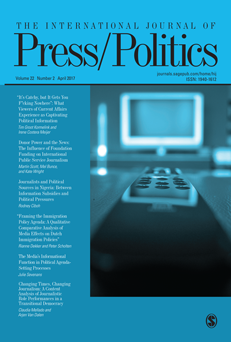Humanitarian reporting has never been lucrative, and with the ongoing decline in budgets and the squeezing of newsrooms resources, news organisations have had to explore new sources of funding. One way of addressing this issue is through foundation funding, but with this comes discussions regarding donor influence. However, this is an under-researched area, and there is a lack of concrete evidence about how donor and journalistic power are negotiated.
By Jon Eilenberg
 One of the only studies to grapple with these questions is presented in an article recently published by Martin Scott, Mel Bunce, and Kate Wright. They provide a detailed case study of the humanitarian news organisation IRIN between November 2014 and November 2015. In this period, IRIN transitioned from being involved with the UN – to being funded by the Jynwel Foundation – to being an independent non-profit association.
One of the only studies to grapple with these questions is presented in an article recently published by Martin Scott, Mel Bunce, and Kate Wright. They provide a detailed case study of the humanitarian news organisation IRIN between November 2014 and November 2015. In this period, IRIN transitioned from being involved with the UN – to being funded by the Jynwel Foundation – to being an independent non-profit association.
The contention of the article is that foundations can potentially influence journalism in the same ways as ownership (following a model by Benson, Hesserus and Sedel). Whilst evidence of direct editorial influence is rare, foundations can potentially shape a news organisations’ target audience, commitment to public service values and the political or economic interests it serves. To examine exactly how these indirect influences can play out, the researchers analysed IRIN’s news outputs, editorial meetings and strategy documents and interviewed all journalists and editors.
IRIN’s changing funding status did have some effect on their news output: the number of news stories and the use of social media both increased while the length of their articles decreased. In terms of content, however, IRIN’s coverage did not become more campaign-oriented or pro-market. The causes of these effects are described in the article as divided into three areas, which reflect the target audience, political or economic interests, and public service values mentioned above.
The first cause was that IRIN began to focus on maximising their audience reach, which was linked to the increased number of shorter news stories. The second cause was competing agendas and cultural differences between journalism, humanitarianism, and philanthro-capitalism, which led to a difficult balancing act for the news workers. The third influence was the agency of the editors and journalists at IRIN – who maintained their editorial independence.
In conclusion, Scott, Bunce, and Wright’s article shows that in the case of IRIN, donor power operated entirely indirectly and always in concert with the professional values of the news organisation. Journalistic culture and agency, and the context in which they are exercised, remain central to the production of humanitarian news. Whilst more research is needed, this study strongly suggests that it is not just a simple case of the donor playing the tune that news organisations follow.
The article ‘Donor Power and the News – The Influence of Foundation Funding on International Public Service Journalism’ is available open access in the ‘International Journal of Press Politics’: http://journals.sagepub.com/doi/full/10.1177/1940161217693394




